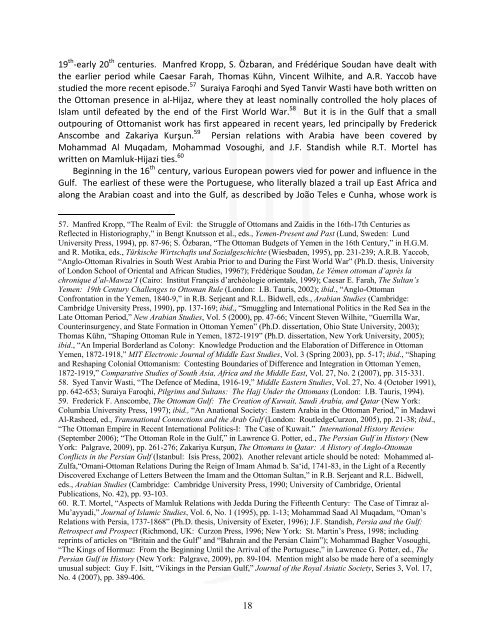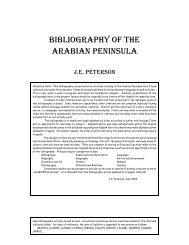THE ARABIAN PENINSULA IN MODERN TIMES: A - JEPeterson.net
THE ARABIAN PENINSULA IN MODERN TIMES: A - JEPeterson.net
THE ARABIAN PENINSULA IN MODERN TIMES: A - JEPeterson.net
Create successful ePaper yourself
Turn your PDF publications into a flip-book with our unique Google optimized e-Paper software.
19 th ‐early 20 th centuries. Manfred Kropp, S. Özbaran, and Frédérique Soudan have dealt with<br />
the earlier period while Caesar Farah, Thomas Kühn, Vincent Wilhite, and A.R. Yaccob have<br />
studied the more recent episode. 57 Suraiya Faroqhi and Syed Tanvir Wasti have both written on<br />
the Ottoman presence in al‐Hijaz, where they at least nominally controlled the holy places of<br />
Islam until defeated by the end of the First World War. 58 But it is in the Gulf that a small<br />
outpouring of Ottomanist work has first appeared in recent years, led principally by Frederick<br />
Anscombe and Zakariya Kurşun. 59 Persian relations with Arabia have been covered by<br />
Mohammad Al Muqadam, Mohammad Vosoughi, and J.F. Standish while R.T. Mortel has<br />
written on Mamluk‐Hijazi ties. 60<br />
Beginning in the 16 th century, various European powers vied for power and influence in the<br />
Gulf. The earliest of these were the Portuguese, who literally blazed a trail up East Africa and<br />
along the Arabian coast and into the Gulf, as described by João Teles e Cunha, whose work is<br />
57. Manfred Kropp, “The Realm of Evil: the Struggle of Ottomans and Zaidis in the 16th-17th Centuries as<br />
Reflected in Historiography,” in Bengt Knutsson et al., eds., Yemen-Present and Past (Lund, Sweden: Lund<br />
University Press, 1994), pp. 87-96; S. Özbaran, “The Ottoman Budgets of Yemen in the 16th Century,” in H.G.M.<br />
and R. Motika, eds., Türkische Wirtschafts und Sozialgeschichte (Wiesbaden, 1995), pp. 231-239; A.R.B. Yaccob,<br />
“Anglo-Ottoman Rivalries in South West Arabia Prior to and During the First World War” (Ph.D. thesis, University<br />
of London School of Oriental and African Studies, 1996?); Frédérique Soudan, Le Yémen ottoman d’après la<br />
chronique d’al-Mawza‘I (Cairo: Institut Français d’archéologie orientale, 1999); Caesar E. Farah, The Sultan’s<br />
Yemen: 19th Century Challenges to Ottoman Rule (London: I.B. Tauris, 2002); ibid., “Anglo-Ottoman<br />
Confrontation in the Yemen, 1840-9,” in R.B. Serjeant and R.L. Bidwell, eds., Arabian Studies (Cambridge:<br />
Cambridge University Press, 1990), pp. 137-169; ibid., “Smuggling and International Politics in the Red Sea in the<br />
Late Ottoman Period,” New Arabian Studies, Vol. 5 (2000), pp. 47-66; Vincent Steven Wilhite, “Guerrilla War,<br />
Counterinsurgency, and State Formation in Ottoman Yemen” (Ph.D. dissertation, Ohio State University, 2003);<br />
Thomas Kühn, “Shaping Ottoman Rule in Yemen, 1872-1919” (Ph.D. dissertation, New York University, 2005);<br />
ibid., “An Imperial Borderland as Colony: Knowledge Production and the Elaboration of Difference in Ottoman<br />
Yemen, 1872-1918,” MIT Electronic Journal of Middle East Studies, Vol. 3 (Spring 2003), pp. 5-17; ibid., “Shaping<br />
and Reshaping Colonial Ottomanism: Contesting Boundaries of Difference and Integration in Ottoman Yemen,<br />
1872-1919,” Comparative Studies of South Asia, Africa and the Middle East, Vol. 27, No. 2 (2007), pp. 315-331.<br />
58. Syed Tanvir Wasti, “The Defence of Medina, 1916-19,” Middle Eastern Studies, Vol. 27, No. 4 (October 1991),<br />
pp. 642-653; Suraiya Faroqhi, Pilgrims and Sultans: The Hajj Under the Ottomans (London: I.B. Tauris, 1994).<br />
59. Frederick F. Anscombe, The Ottoman Gulf: The Creation of Kuwait, Saudi Arabia, and Qatar (New York:<br />
Columbia University Press, 1997); ibid., “An Anational Society: Eastern Arabia in the Ottoman Period,” in Madawi<br />
Al-Rasheed, ed., Transnational Connections and the Arab Gulf (London: RoutledgeCurzon, 2005), pp. 21-38; ibid.,<br />
“The Ottoman Empire in Recent International Politics-I: The Case of Kuwait.” International History Review<br />
(September 2006); “The Ottoman Role in the Gulf,” in Lawrence G. Potter, ed., The Persian Gulf in History (New<br />
York: Palgrave, 2009), pp. 261-276; Zakariya Kurşun, The Ottomans in Qatar: A History of Anglo-Ottoman<br />
Conflicts in the Persian Gulf (Istanbul: Isis Press, 2002). Another relevant article should be noted: Mohammed al-<br />
Zulfa,“Omani-Ottoman Relations During the Reign of Imam Ahmad b. Sa‘id, 1741-83, in the Light of a Recently<br />
Discovered Exchange of Letters Between the Imam and the Ottoman Sultan,” in R.B. Serjeant and R.L. Bidwell,<br />
eds., Arabian Studies (Cambridge: Cambridge University Press, 1990; University of Cambridge, Oriental<br />
Publications, No. 42), pp. 93-103.<br />
60. R.T. Mortel, “Aspects of Mamluk Relations with Jedda During the Fifteenth Century: The Case of Timraz al-<br />
Mu’ayyadi,” Journal of Islamic Studies, Vol. 6, No. 1 (1995), pp. 1-13; Mohammad Saad Al Muqadam, “Oman’s<br />
Relations with Persia, 1737-1868” (Ph.D. thesis, University of Exeter, 1996); J.F. Standish, Persia and the Gulf:<br />
Retrospect and Prospect (Richmond, UK: Curzon Press, 1996; New York: St. Martin’s Press, 1998; including<br />
reprints of articles on “Britain and the Gulf” and “Bahrain and the Persian Claim”); Mohammad Bagher Vosoughi,<br />
“The Kings of Hormuz: From the Beginning Until the Arrival of the Portuguese,” in Lawrence G. Potter, ed., The<br />
Persian Gulf in History (New York: Palgrave, 2009), pp. 89-104. Mention might also be made here of a seemingly<br />
unusual subject: Guy F. Isitt, “Vikings in the Persian Gulf,” Journal of the Royal Asiatic Society, Series 3, Vol. 17,<br />
No. 4 (2007), pp. 389-406.<br />
18







